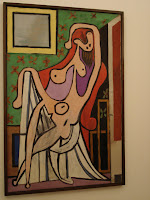 Yesterday I toured the Picasso Museum. Rick Steves says to allow an hour and I don’t believe I was there a minute longer—or it’s possible that I wasn’t even there an hour... I’ve never been a fan of modern art but I have learned to look at it with a fresh eye and to try and keep an open mind.
Yesterday I toured the Picasso Museum. Rick Steves says to allow an hour and I don’t believe I was there a minute longer—or it’s possible that I wasn’t even there an hour... I’ve never been a fan of modern art but I have learned to look at it with a fresh eye and to try and keep an open mind.I’ve always wondered what makes a painter famous—what is it about his or her work that propels that particular artist into the famous-ness zone? (Why
 not the artists of other works—the ones you see for sale on weekends for $29.99?) Take the "Mona Lisa," for example. What is it about that painting that makes it priceless and sends zillions of people to robotically seek her out every year? Yes, I go to see the "Mona Lisa" because—well, she is the Mona Lisa. But there are many, many other paintings in the Louvre that please my eyes more.
not the artists of other works—the ones you see for sale on weekends for $29.99?) Take the "Mona Lisa," for example. What is it about that painting that makes it priceless and sends zillions of people to robotically seek her out every year? Yes, I go to see the "Mona Lisa" because—well, she is the Mona Lisa. But there are many, many other paintings in the Louvre that please my eyes more. 
Anyway, I digress, as usual. Back to Picasso and modern art. This museum is housed in the 17th-century Hotel Sale (salty)—called this because its first owner made his fortune by charging a tax on salt. (Remember that hotel usually refers to a grand private residence here.) This is the largest collection of Picasso’s works, of which a large proportion belonged to Picasso at the time of his death in 1973. The state had first option on them in lieu of the taxes that he owed. His most recognizable works are in the Pompidou Center here in Paris but this collection gives you a sense of his growth as an artist.

It also reminds you that he was not only a painter but a sculpture as well. Some of his paintings, especially in his early years, seem almost “normal” (to me) as he mimicked the styles of a number of other artists, many who were friends with whom he hung out while living in Montmartre. One that comes to mind is of his son done in 1924 (not really his early years but his life was more settled at this time), Paulo en Harlequin (shown above). By this time, he had already invented Cubism and all hell broke loose. Well, OK, maybe I exaggerate, but his paintings got more fragmented, chunky, jumbled, geometric—and not in a “make sense” kind of way—again, just my opinion. And when you could make out a figure of a woman, for example, they all seemed to have ample bodies, hands, legs, etc.—not always proportional but what we’d call a "full-figured woman," for sure.

As well as Cubism, Picasso is also known for inventing the collage technique where he used all types of materials like wire, drawing paper, sand, wood, rope, even chair caning. Plus he did prints, engravings, and ceramics. The owners of a pottery workshop where he worked while he experimented, however, said, "If an apprentice worked like Picasso, he would never be employed.” That’s simply because he disregarded all the traditional ceramist techniques and invented his own. But he was Picasso and he could do whatever he wanted!
 And so after developing a headache—just kidding—I escaped out into the sunlight. At least I feel like I am more exposed to his work and have a better understanding of his life and motivations. And I even saw some work of his that I enjoyed. Good for me.
And so after developing a headache—just kidding—I escaped out into the sunlight. At least I feel like I am more exposed to his work and have a better understanding of his life and motivations. And I even saw some work of his that I enjoyed. Good for me. 